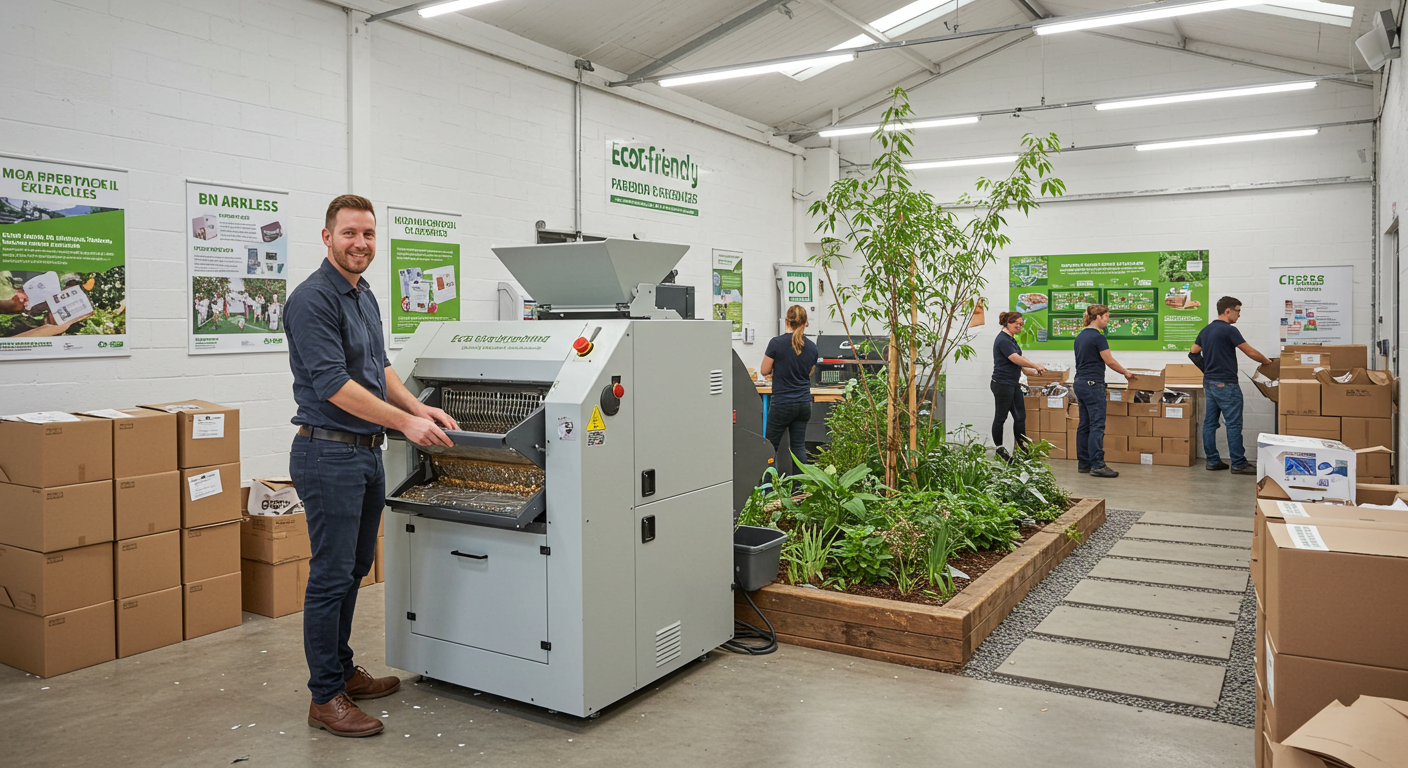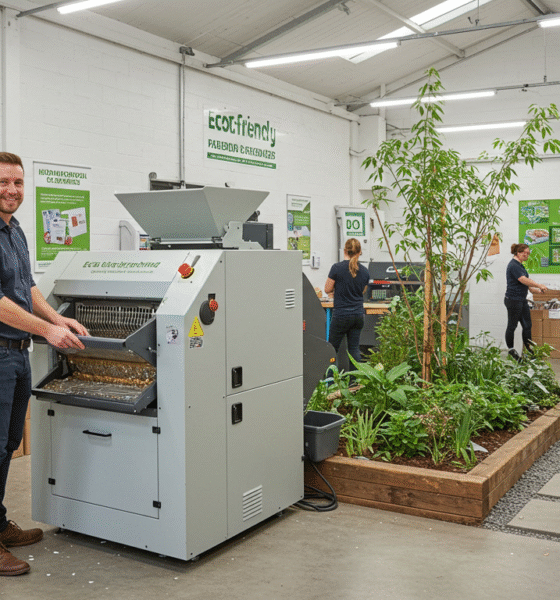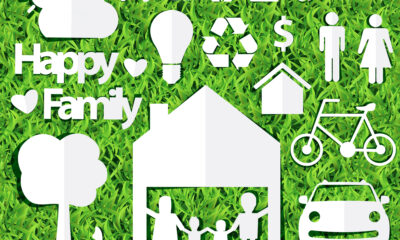One thing that we wanted to talk more about at Blue and Green Tomorrow is the importance of running an eco-friendly office. You might not realize it, but small daily choices in the workplace can add up to large impacts on both the environment and the business itself.
Megan Starkey of Record Nations reports that the average office worker uses 10,000 sheets of copy paper each year, and that by the end of the day, 45% of paper printed in offices ends up in the trash. It is clear from these numbers that there are big opportunities for change. Keep reading to learn more.
The Hidden Paper Problem
There are many areas in office life where wasteful practices become routine without much thought. You often see stacks of paper documents piling up that could easily be reduced through smarter systems.
It is often overlooked that secure shredding programs can help reduce unnecessary storage and encourage recycling. You can think of shredding not just as protection for data but also as a chance to reintroduce materials back into the supply chain.
A study from the University of Built Environment revealed that 98% of 300 businesses surveyed had failed to meet the objectives set out in their sustainability initiatives. You might wonder how organizations that set clear goals end up falling short.
There are clear gaps between intention and action when it comes to building greener workplaces. It is through practical steps like paper reduction and recycling that companies can start closing this gap.
The US Bureau of Labor Statistics has reported that 20.4% of businesses fail in their first year after opening. You may think that green-focused companies are immune, but Harvard Business Review pointed out in its article The Elusive Green Consumer that these businesses often face the same struggles.
It is a sobering fact that the drive to be more environmentally conscious does not guarantee financial survival. You can see why small but consistent practices like secure shredding can be part of balancing responsibility with practicality.
There are strong reasons to connect shredding programs to larger eco-friendly goals. You might see them as purely about security, but they can also be structured to recycle large amounts of waste paper.
It is true that many shredding services send the remains to be pulped and reused, lowering the demand for virgin paper. You can look at this as a direct way to lower both office waste and deforestation pressures.
It is common for employees to underestimate the effects of their printing habits. You may not realize that every document printed without need adds to both cost and carbon output.
There are also cultural benefits when employees know that secure shredding and recycling are part of their workplace. You can create a sense of accountability when everyone plays a part in reducing waste.
Balancing Security and Sustainability
You can see how data security concerns often overlap with sustainability goals. It is possible to address both at the same time by running secure shredding systems that feed into recycling.
There are companies that already show this balance is achievable by offering eco-certified shredding programs. You can think of this as one example of how protecting sensitive information and reducing waste go hand in hand.
Long-Term Benefits
It is often said that businesses that survive focus on both short-term savings and long-term resilience. You may find that adopting green policies like secure shredding is one way to accomplish both.
There are cost savings when offices cut down on wasted paper, and there are reputational gains when they show a clear commitment to sustainability. You can see how this creates momentum that supports both employees and clients.
In today’s digital world, it is easy to assume that the need for paper has diminished. Yet, paper continues to dominate in offices, schools, healthcare facilities, financial institutions, and households. With this comes the inevitable issue of waste, particularly sensitive documents that must be disposed of securely. While the immediate purpose of paper shredding is to protect individuals and organisations from identity theft, fraud, and data breaches, there is a much larger story to tell: its impact on environmental sustainability. Secure paper shredding not only addresses information security but also plays a vital role in reducing waste, conserving resources, and promoting recycling. This dual purpose makes shredding an essential practice for both business and environmental responsibility.
The Link Between Paper Use and Environmental Impact
Paper production has long been associated with deforestation, water consumption, and energy-intensive processes. While paper is recyclable, the sheer volume produced globally continues to place immense pressure on natural resources. A single tonne of virgin paper can require up to 24 trees, 90,000 litres of water, and a significant amount of energy. Additionally, if discarded improperly, paper waste contributes to landfill overflow, where it can release methane as it decomposes.
This environmental burden underscores the importance of ensuring paper is not simply thrown away but recycled properly. Secure shredding offers a direct pathway for paper waste to be reintegrated into the recycling stream, transforming what could be an environmental liability into a resource for creating new paper products.
Why Secure Shredding Matters Beyond Security
Most people associate shredding with security concerns, and rightly so. With increasing threats of identity theft and corporate espionage, secure disposal of sensitive information is non-negotiable. However, shredding services also act as a bridge between secure destruction and sustainable recycling.
When paper is shredded professionally, it is usually baled and sent to paper mills. There, it is pulped and repurposed into new materials such as packaging, tissues, or recycled office paper. Without shredding, much of this paper may be discarded improperly, resulting in higher volumes of waste. By making shredding part of a regular routine, organisations and individuals can ensure that paper follows a closed-loop cycle rather than contributing to environmental harm.
The Recycling Potential of Shredded Paper
One of the strongest arguments for secure shredding’s environmental role lies in the recycling process. Shredded paper, when collected and processed correctly, can be recycled up to seven times before the fibres become too short to reuse. This repeated cycle reduces the need for virgin paper production, thereby lowering the demand for wood, water, and energy.
Moreover, recycling paper significantly cuts greenhouse gas emissions. Producing recycled paper generates 40–70% less CO2 than manufacturing paper from raw materials. By ensuring shredded paper is fed into the recycling stream, businesses and households actively contribute to carbon footprint reduction.
Conserving Natural Resources
Secure shredding indirectly conserves forests, which are critical to combating climate change and preserving biodiversity. Every tonne of recycled paper saves approximately 17 trees, along with thousands of litres of water and reduced energy consumption. Shredded paper recycling, therefore, not only mitigates waste but also contributes to broader conservation efforts.
In addition, recycling shredded paper helps protect ecosystems that would otherwise be disrupted by logging. Forests serve as natural carbon sinks and habitats for countless species, making paper recycling an essential part of environmental sustainability. Shredding is a practical first step in ensuring paper makes its way to recycling centres instead of being lost in landfills.
Preventing Landfill Overflow and Pollution
Landfills are a growing environmental challenge. Paper waste still makes up a significant portion of landfill materials, despite its recyclability. When paper decomposes in a landfill, it produces methane, a greenhouse gas significantly more potent than carbon dioxide. Secure shredding, when combined with recycling, directly reduces the volume of waste ending up in landfill sites.
Furthermore, improper disposal of documents, such as burning or unregulated dumping, contributes to air pollution and environmental degradation. Shredding provides an environmentally sound alternative that aligns with waste reduction goals and promotes sustainable practices.
Corporate Responsibility and Environmental Credentials
For organisations, secure shredding is not just a matter of compliance with data protection regulations but also a chance to enhance environmental credentials. Many companies today are expected to demonstrate their commitment to sustainability. Implementing a shredding and recycling programme enables businesses to show measurable impact, from reducing waste volumes to contributing to carbon savings.
Shredding also supports corporate social responsibility (CSR) initiatives. By adopting environmentally friendly document disposal methods, companies can demonstrate leadership, build stakeholder trust, and strengthen their brand image. Clients and consumers are increasingly drawn to organisations that prioritise both security and sustainability.
Reducing Energy Demand
Another overlooked benefit of secure shredding is its contribution to energy efficiency. Recycling shredded paper requires considerably less energy than producing paper from raw materials. Studies suggest that recycling one tonne of paper saves enough energy to power the average home for six months.
When secure shredding feeds into recycling, it reduces the overall energy demand for paper production. This, in turn, lowers reliance on fossil fuels and helps combat climate change by reducing greenhouse gas emissions.
Challenges in Shredded Paper Recycling
While secure shredding plays a vital role, it is important to acknowledge the challenges involved. Shredded paper fibres are shorter than unprocessed paper, making them less valuable for recycling into high-grade products. Additionally, shredded paper can cause difficulties in sorting facilities, as small pieces may clog machinery or be mistakenly discarded.
However, these challenges can be addressed through proper handling. Using professional shredding services ensures paper is collected in bulk, baled, and directed to the appropriate mills. Consumers can also help by keeping shredded paper free from contamination, such as plastic or food waste, which compromises recyclability.
Combining Digital Transformation with Secure Shredding
Although businesses are shifting towards digital processes to reduce reliance on paper, the transition is far from complete. Sensitive documents in physical form remain a reality across industries. Combining digitalisation efforts with secure shredding ensures a balanced approach: reducing future paper use while responsibly managing existing paper waste.
By adopting secure shredding alongside digital storage, organisations can achieve a dual benefit of reducing their environmental impact while maintaining compliance with data protection laws. This integrated approach ensures that sustainability and security go hand in hand.
The Takeaway
Secure paper shredding is often seen solely as a measure of data protection, but its environmental implications are equally profound. By ensuring shredded paper is recycled, individuals and organisations actively reduce landfill waste, conserve forests, cut energy consumption, and lower greenhouse gas emissions. The practice strengthens corporate sustainability efforts, supports conservation, and aligns with global goals of building a circular economy.
In a world where environmental responsibility is no longer optional, secure shredding offers a simple yet powerful way to combine security with sustainability. Every document shredded and recycled is a step towards protecting both information and the planet. By embracing secure paper shredding, society can work towards a future where waste becomes a resource and environmental sustainability is embedded in everyday practices.


 Environment10 months ago
Environment10 months agoAre Polymer Banknotes: an Eco-Friendly Trend or a Groundswell?

 Environment11 months ago
Environment11 months agoEco-Friendly Home Improvements: Top 7 Upgrades for 2025

 Features9 months ago
Features9 months agoEco-Friendly Cryptocurrencies: Sustainable Investment Choices

 Features10 months ago
Features10 months agoEco-Friendly Crypto Traders Must Find the Right Exchange




















